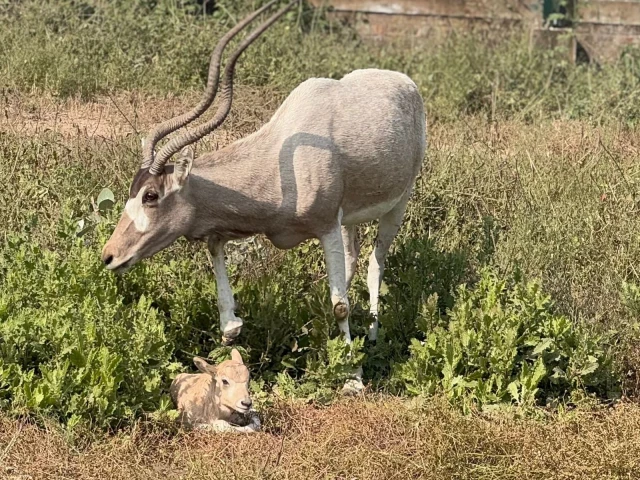Baby Addax, Arabian Oryx born at Lahore Safari Park
Addax conserves moisture by feeding on desert plants, adjusting its activity to avoid extreme heat

The birth of baby Addax and Arabian Oryx at Lahore Safari Park has increased the herd’s population. According to park management, one newborn has been recorded in each species, bringing the total number of Addax to fourteen and Arabian Oryx to nine. The current Addax herd consists of four males, seven females, and three young ones, while the Oryx herd includes three males, three females, and three young ones.
According to Dr. Rizwan Khan, Director of Veterinary Services at the Wildlife Safari Zoo, these animals were brought to Lahore in March 2024 under the Safari Upgradation Project. “The non-native species are provided round-the-clock veterinary care, along with spacious enclosures where they are kept alongside other compatible species,” he said.
The addax, or white antelope, is a critically endangered species native primarily to the Sahara Desert of North Africa, where it inhabits semi-arid plains, coastal deserts, and sparse shrublands. Its pale coat, broad sand-adapted hooves, and ability to survive for days without drinking water make it exceptionally suited to harsh desert climates.
The addax conserves moisture by feeding on desert plants and adjusting its activity to avoid extreme heat. Once widespread across North Africa, its wild numbers have been drastically reduced by habitat loss and poaching, leaving only small, fragmented populations in remote areas.
Read: Sambar deer crossing from India rescued in Narowal
The Arabian oryx is a straight-horned, long-horned antelope native to the Arabian Peninsula and officially recognized as the national animal of the United Arab Emirates.
Adapted to semi-arid plains, coastal deserts, and shrublands, it can endure intense heat and survive for extended periods without water by relying on moisture-rich vegetation. Its striking white coat and long, parallel horns give it a distinctive appearance, while its ability to detect distant rainfall helps it track fresh plant growth. Once extinct in the wild, the species has been successfully reintroduced through conservation programs and now maintains stable populations in protected areas.
Both the addax and the Arabian oryx are desert-adapted antelopes capable of surviving harsh climates, including prolonged periods without water. They share similar habitats, semi-arid plains, coastal deserts, and shrublands, and exhibit specialized physiological and behavioral traits that allow them to thrive in extreme arid environments
Dr. Khan explained that their diet is managed under a structured feeding plan, ensuring that each animal receives the required nutrition. “Consistent monitoring, proper care, and the improved living environment have resulted in healthy new births within the herd,” he added.
Regarding diet, Safari Park officials stated that both Addax and Oryx feed on grasses, desert shrubs, leaves, and occasionally roots. In the safari, they are provided with fresh fodder and special mineral supplements to support their growth and maintain good health.
Earlier, the Lahore Zoo had also recorded the birth of a baby Nyala antelope. The management says the new births are not only an indication of the success of the breeding programme but also an indicator of a safe wildlife environment within the Safari Park, where conservation and population growth of specific species continue under a structured plan.





















COMMENTS
Comments are moderated and generally will be posted if they are on-topic and not abusive.
For more information, please see our Comments FAQ